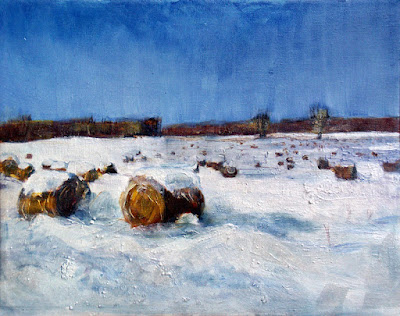Exciting weather means exciting skies, but it can also be a pain to paint in.
 |
| Breaking storm, pastel, Carol L. Douglas |
I personally object to tornados and snowstorms on the same day. It’s like still having acne when you’re getting wrinkles. But that’s been the kind of spring we’re getting.
We had a lovely Memorial Day weekend here in mid-coast Maine. When Tuesday dawned clear, I thought we’d be fine to open our new session of painting classesdown at the harbor. Wrong. We were right back into the sub-normal temperatures we’ve had all spring.
In the Rockies, the weather has been more characteristic of late winter than late May. My youngest is on a field trip in southern Colorado. He called to tell me about ice on his tent and snowstorms. “I hope you’re sleeping in your jacket,” I said.
“I hate to break it to you, Mom, but I always sleep in my clothes,” he said. Geesh.
| David Blanchard and I tough it out on an unseasonably cold day at Rockport Harbor. Photo courtesy of Jennifer Johnson. |
The Rocky Mountain snowpack—which was at historic lows for the last two years—has recovered with a vengeance. Meanwhile, the southeast United States is baking, there’s flooding in the Midwest, and Tornado Alley has been on a tear. The cause, apparently, is ‘persistent big meanders’ in the polar jet stream. These waves are in a pattern across the Rockies, the Great Lakes and exiting through Maine. Weather is, by nature, always extreme somewhere.
Unfortunately, I no longer live where the future is writ on the clouds. Here, the sensible Old Salts rely on the weather forecast, not on their bones. But I do know one universal truth: the best predictor of tomorrow’s weather is what is happening today. For us, that means more rain and cool temperatures.
 |
| Deborah RoyRoberts comes up with a solution to dropping brushes on a dock. Every car has a floor mat, right? |
What does this mean for the plein air painter? Foremost, it means not getting too far away from your car. Lightning strikes on both the leading and trailing edges of thunderstorms. Even if the sky directly over your head is clear, you’re at risk of a strike when you can hear thunder. Far better to record the pyrotechnics from your front seat.
Moreover, there will be changing lighting conditions. The only answer to this is a good preparatory sketch before you start painting.
 |
| This sketch of Lake Huron in a storm was done from next to my car in a parking lot. You need to allow for quick getaways in bad weather. |
Watercolors and pastel are very difficult to manage in a downpour, even when they’re out of the direct rain. Paper and chalk both become saturated with moisture, making control impossible. The only solution I know is to work from inside your car. Acrylics actually benefit from higher humidity, but sideways mist and rain will make them run off the canvas too.
Remember learning that oil and water don’t mix? Instead, they form a stodge that’s impossible to paint with. The only way to paint with oils in the rain is to keep your canvas and palette dry.



